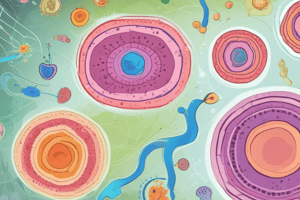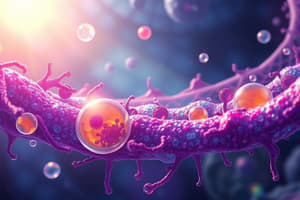Podcast
Questions and Answers
What is the primary function of the mitochondrial matrix?
What is the primary function of the mitochondrial matrix?
- To store enzymes and proteins involved in cellular respiration (correct)
- To separate the inner and outer mitochondrial membranes
- To fold into cristae
- To generate ATP in the absence of oxygen
In which type of cells are organelles absent?
In which type of cells are organelles absent?
- Eukaryotic cells
- Prokaryotic cells (correct)
- Cells that undergo anaerobic fermentation
- Cells that undergo cellular respiration
What is the primary difference between cellular respiration and anaerobic fermentation?
What is the primary difference between cellular respiration and anaerobic fermentation?
- The type of molecules involved
- The location of the process within the cell
- The amount of ATP produced
- The presence of oxygen (correct)
What is the purpose of the cristae in the mitochondria?
What is the purpose of the cristae in the mitochondria?
In which organelle does cellular respiration occur?
In which organelle does cellular respiration occur?
What is the primary function of the electron transport chain in mitochondrial function?
What is the primary function of the electron transport chain in mitochondrial function?
Which organelle is responsible for breaking down toxic substances and waste?
Which organelle is responsible for breaking down toxic substances and waste?
What is the name of the protein complex that generates ATP in mitochondrial function?
What is the name of the protein complex that generates ATP in mitochondrial function?
Which organelle has a third, internal membrane called the thylakoid membrane?
Which organelle has a third, internal membrane called the thylakoid membrane?
What is the term for the process by which cells generate ATP in low-oxygen environments?
What is the term for the process by which cells generate ATP in low-oxygen environments?
Study Notes
Cell Organelles: Understanding Cellular Respiration, Anaerobic Fermentation, Mitochondrial Function, Chloroplast Structure, and Organelle Specialization
Cell organelles are specialized structures within cells that perform specific tasks. These sub-units are similar to organs in the human body, serving specific functions to keep the cell alive. Organelles are absent in prokaryotic cells, which are simpler in structure, but are present in eukaryotic cells, which are more complex and diverse. In this article, we will discuss the subtopics of cellular respiration, anaerobic fermentation, mitochondrial function, chloroplast structure, and organelle specialization.
Cellular Respiration and Anaerobic Fermentation
Cellular respiration is the process by which cells convert biochemical energy from nutrients into adenosine triphosphate (ATP), a molecule that provides energy for cellular processes. This process occurs in the mitochondria, which are organelles found in eukaryotic cells. Mitochondria contain two layers of membranes: an outer membrane and an inner membrane. The space between these membranes is called the intermembrane space, and the inner membrane folds into structures called cristae. The area between the inner and outer membranes is called the mitochondrial matrix, which contains enzymes and proteins involved in cellular respiration.
Anaerobic fermentation is an alternative process for producing ATP when oxygen is not available. This process occurs in the cytoplasm of the cell and involves the breakdown of glucose into lactic acid or other end products. Fermentation does not produce as much ATP as cellular respiration, but it is a crucial survival mechanism for cells in low-oxygen environments.
Mitochondrial Function
Mitochondria play a crucial role in cellular respiration, producing ATP through a process called oxidative phosphorylation. This process involves the electron transport chain, which is a series of protein complexes that transfer electrons from electron donors to electron acceptors. The energy released during this process is used to pump protons across the inner mitochondrial membrane, creating a proton gradient. The protons then flow back through a protein complex called ATP synthase, which generates ATP.
Chloroplast Structure
Chloroplasts are organelles found in plant cells that are responsible for converting sunlight into chemical energy. Chloroplasts contain a double membrane and retain their own DNA. Unlike mitochondria, the inner membrane of chloroplasts is not folded. Chloroplasts also have a third, internal membrane called the thylakoid membrane, which is folded. The fluid inside the chloroplasts is called the stroma, and it is filled with proteins and chloroplast DNA.
Organelle Specialization
Organelles have specific roles and functions within cells. For example, mitochondria produce ATP, while chloroplasts convert sunlight into energy. Other organelles, such as lysosomes, are responsible for breaking down toxic substances and waste. The Golgi apparatus is involved in protein modification and export, while the endoplasmic reticulum (ER) is involved in lipid production and protein synthesis. Peroxisomes are organelles that help break down lipids, and they are formed from the ER.
In summary, cell organelles are specialized structures within cells that perform specific tasks, such as cellular respiration, anaerobic fermentation, mitochondrial function, chloroplast structure, and organelle specialization. Understanding these processes is crucial for understanding how cells function and maintain life.
Studying That Suits You
Use AI to generate personalized quizzes and flashcards to suit your learning preferences.
Description
Explore the functions and structures of cell organelles, including mitochondria and chloroplasts, and their roles in cellular respiration, anaerobic fermentation, and energy production. Learn about the specialization of organelles and their importance in cellular processes.




